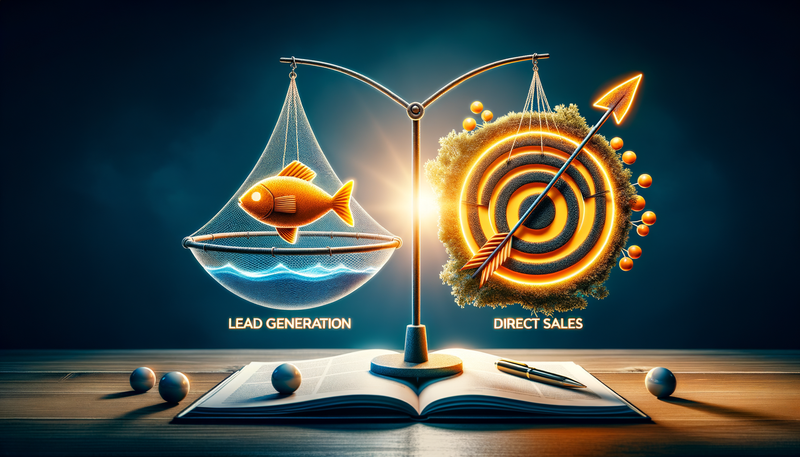Designing Landing Pages for Lead Generation vs. Direct Sales
Landing pages are crucial tools in digital marketing, serving as the gateway for conversion. However, the design and strategy for these pages can vary significantly depending on whether the goal is lead generation or direct sales. This article explores the key differences in approach when creating landing pages for these distinct objectives. We'll delve into the specific elements, tactics, and best practices for each type of landing page, helping you understand how to tailor your design to maximize your conversion rates. Whether you're looking to build a robust email list or drive immediate purchases, understanding these strategies will empower you to create more effective landing pages.Table of Contents:

Understanding the Goals: Lead Generation vs. Direct Sales
Before diving into design strategies, it's crucial to understand the fundamental differences between lead generation and direct sales goals. Lead generation landing pages aim to collect visitor information, typically email addresses, for future marketing efforts. These pages focus on building a relationship and nurturing potential customers over time.On the other hand, direct sales landing pages are designed to convince visitors to make an immediate purchase. They need to provide all the necessary information and motivation for a visitor to complete a transaction on the spot. Recognizing these distinct goals is the first step in tailoring your landing page design effectively.
Do you need a website? Want to build a website but don't know where to start? Our website builder is the perfect solution. Easy to use, and with the ability to customize to fit your business needs, you can have a professional website in no time.
Key Elements of Lead Generation Landing Pages
Lead generation landing pages should be simple and focused. The primary element is the lead capture form, which should be prominently displayed and easy to fill out. Include only essential fields to reduce friction.Offer a compelling lead magnet, such as a free e-book, whitepaper, or webinar, to incentivize visitors to share their information. Use persuasive copy that highlights the value of your offer without overwhelming the visitor with too much information.
Include social proof elements like testimonials or user statistics to build trust. Ensure the page has a clear and compelling call-to-action (CTA) that encourages visitors to sign up or subscribe. Remove navigation menus and other distractions to keep the focus on the lead capture form.
Designing for Direct Sales Landing Pages
Direct sales landing pages require a more comprehensive approach. They need to provide detailed product information, including features, benefits, and pricing. Use high-quality images or videos to showcase the product effectively.Include customer reviews and ratings to build credibility and trust. Address potential objections or concerns in your copy to overcome hesitation.
Create a sense of urgency with limited-time offers or scarcity tactics. The CTA should be bold and clear, directing visitors to 'Buy Now' or 'Add to Cart'. Include trust badges and security seals to reassure customers about the safety of their transaction. Consider offering multiple payment options to cater to different preferences.
Building a website with SITE123 is easy
Optimizing Page Layout and Design
For both types of landing pages, a clean and professional design is essential. Use a layout that guides the visitor's eye towards the main conversion goal. For lead generation pages, this means drawing attention to the sign-up form. For direct sales pages, focus on highlighting product benefits and the purchase button.Use contrasting colors for your CTA buttons to make them stand out. Ensure your page is mobile-responsive, as a significant portion of traffic may come from mobile devices. Use whitespace effectively to avoid cluttering the page and to improve readability.
For direct sales pages, consider using a long-form design that allows for more detailed information, while still maintaining clear CTAs throughout the page. For lead generation, a shorter, more focused design often works best.
Crafting Compelling Copy
The copy on your landing page should be tailored to your specific goal. For lead generation, focus on the value of the offer and what the visitor will gain by signing up. Use bullet points to highlight key benefits and keep the language concise and persuasive.For direct sales pages, your copy needs to be more comprehensive. Start with a strong headline that captures attention and conveys your unique value proposition. Use subheadings to break up the text and make it scannable. Address potential questions or objections in your copy, and use persuasive language that emphasizes the benefits of making a purchase now.
Leveraging Social Proof and Trust Signals
Both types of landing pages benefit from social proof, but the application differs slightly. For lead generation pages, testimonials about the quality of your content or the value of your newsletter can be effective. Include numbers, such as the size of your subscriber list, to build credibility.On direct sales pages, customer reviews and ratings are crucial. Showcase detailed testimonials that speak to the product's benefits and effectiveness. Include trust badges, security seals, and money-back guarantees to alleviate concerns about online purchases. Displaying logos of well-known clients or media features can also boost credibility for both types of pages.
Testing and Optimization Strategies
Regardless of your landing page's goal, continuous testing and optimization are key to improving performance. For lead generation pages, test different lead magnets, form layouts, and CTA copy to see what resonates best with your audience.For direct sales pages, experiment with various pricing strategies, product descriptions, and page lengths. Use A/B testing to compare different versions of your page and analyze which elements drive higher conversion rates.
Pay attention to metrics like bounce rate, time on page, and form completion rate for lead generation pages. For direct sales pages, focus on add-to-cart rates, checkout completion rates, and average order value. Use heat mapping tools to understand how visitors interact with your page and identify areas for improvement.





